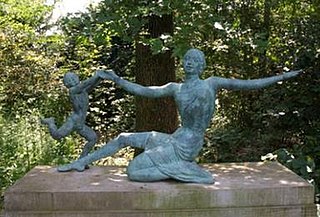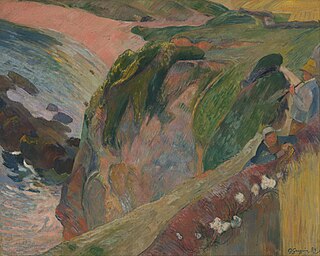
A putto is a figure in a work of art depicted as a chubby male child, usually naked and very often winged. Originally limited to profane passions in symbolism, the putto came to represent a sort of baby angel in religious art, often called a cherub, though in traditional Christian theology a cherub is actually one of the most senior types of angel.

The Indianapolis Museum of Art (IMA) is an encyclopedic art museum located at Newfields, a 152-acre (62 ha) campus that also houses Lilly House, The Virginia B. Fairbanks Art & Nature Park: 100 Acres, the Gardens at Newfields, the Beer Garden, and more. It is located at the corner of North Michigan Road and West 38th Street, about three miles north of downtown Indianapolis, northwest of Crown Hill Cemetery. There are exhibitions, classes, tours, and events, many of which change seasonally. The entire campus and organization was previously referred to as the Indianapolis Museum of Art, but in 2017 the campus and organization were renamed "Newfields" as part of a branding campaign. The "Indianapolis Museum of Art" now specifically refers to the main art museum building that acts as the cornerstone of the campus, as well as the legal name of the organization doing business as Newfields.

Oldfields, also known as Lilly House and Gardens, is a 26-acre (11 ha) historic estate and house museum at Newfields in Indianapolis, Indiana, United States. The estate, an example of the American country house movement of the late nineteenth and early twentieth centuries, was designated a U.S. National Historic Landmark in 2003.

Numbers 1-0 is a public artwork by the American artist Robert Indiana, located at the Indianapolis Museum of Art (IMA), which is near downtown Indianapolis, Indiana. This series of sculptures is composed of 10 brightly painted numerical digits, each made of aluminum and set on its own base. Their construction took place at the former Lippincott Foundry in North Haven, Connecticut from 1980 to 1983.

The Values of Civilization sculpture group is public art by American artist Alexander Doyle. The allegorical sculpture group is located on the third floor in the rotunda of the Indiana State House, which is in Indianapolis, Indiana, United States. The heroic-sized sculptures, representing Agriculture, Art, Commerce, History, Justice, Law, Liberty, and Oratory, were carved from Carrara marble in Italy in the late 1880s.

Stumbling Man is an outdoor sculpture by American artist David K. Rubins (1902–1985) located on the grounds of the Indianapolis Museum of Art (IMA), which is near downtown Indianapolis, Indiana. The sculpture is cast bronze and is in the shape of a man crouched upon the ground.

Sundial, Boy With Spider is an outdoor sculpture and functional sundial by American artist Willard Dryden Paddock (1873–1956). It is located within the Oldfields estate on the grounds of the Indianapolis Museum of Art (IMA), in Indianapolis, Indiana, United States. The bronze sculpture, cast by the Gorham Manufacturing Company, depicts a boy sitting cross-legged with an open scroll in his lap.

Nymph and Fawn is a public artwork by American artist Isidore Konti and located within the Oldfields–Lilly House & Gardens estate on the grounds of the Indianapolis Museum of Art (IMA), near Indianapolis, Indiana. Created in 1917, the bronze sculpture is also a working fountain. It portrays a female nude pouring water from an urn while standing beside a small fawn.

LOVE is an artwork by American pop artist Robert Indiana (1928–2018), located at the Indianapolis Museum of Art at Newfields in Indianapolis, Indiana, United States. It was created in 1970 as the first sculptural form of the artist's 1965 LOVE painting and has been on continuous exhibition at the Indianapolis Museum of Art since it was acquired in 1975.

Mother and Child is a public artwork by the Estonian-British artist Dora Gordine, located at the Indianapolis Museum of Art (IMA), which is near downtown Indianapolis, Indiana. The cast bronze artwork was created in 1964 and portrays a woman kneeling beside a small child, both figures displaying joyful poses and expressions.
La Hermana del Hombre Bóveda is a public artwork by Spanish artist Pablo Serrano, located at Newfields, the museum campus that houses the Indianapolis Museum of Art near downtown Indianapolis, Indiana. The artwork is an abstract bronze piece which tops a granite fountain.

The Three Graces is a nearly life-size, figurative Carrara marble outdoor sculpture group located on the historic Oldfields estate on the campus of the Indianapolis Museum of Art (IMA), in Indianapolis, Indiana. The neoclassical marble sculpture depicts the Three Graces, minor goddesses of the Greco-Roman pantheon. The group consists of three women frontally oriented, standing in a row upon a base. The sculpture is modeled after a c. 1797 sculpture by Antonio Canova.

Female Herm and Male Herm are a set of two neoclassical marble herms in the outdoor sculpture collection of the historic Oldfields estate, located on the campus of the Indianapolis Museum of Art (IMA), in Indianapolis, Indiana. Together the herms depict either Dionysus and a Maenad or a dryad and a satyr.

Birdbath, constructed of fieldstone and concrete, is an early 20th-century decorative feature on the historic Oldfields estate on the campus of the Indianapolis Museum of Art (IMA), in Indianapolis, Indiana. It is now an accessioned work of art in the collection of the IMA.

The Flageolet Player on the Cliff is an 1889 oil painting by French artist Paul Gauguin, located in the Indianapolis Museum of Art, which is in Indianapolis, Indiana. It depicts a Breton couple on a narrow path precipitously overlooking the Atlantic.

Roman Capriccio: The Pantheon and Other Monuments is a 1735 oil painting by Italian artist Giovanni Paolo Panini, located in the Indianapolis Museum of Art, which is in Indianapolis, Indiana. It depicts an array of famous Roman monuments in a rural setting.

Triptych of the Annunciation is a 1483 triptych by the Flemish artist known only as the Master of the Legend of Saint Ursula, located in the Indianapolis Museum of Art, which is in Indianapolis, Indiana. It depicts the Annunciation on the central panel, while the surrounding panels and the outside of the wings are covered in various pairs of male saints.
This wooden female ancestor figure by an unknown Senufo artisan is part of the African collection of the Indianapolis Museum of Art, which is in Indianapolis, Indiana. Carved in the first half of the 20th century, it displays the artist's skill with form and respect for the powerful female half of the primordial couple.

The Tomb of Ferdinand van den Eynde is a sculptural monument designed and executed by François Duquesnoy. It is located in the church of Santa Maria dell'Anima in Rome. Duquesnoy secured the commission for this work thanks to Pietro Pescatore, alias De Visschere, or Pieter Visscher, a Flemish merchant. The site for Eynde's epitaph was granted by the church administration on August 3, 1633. Visscher and Baldoin Breyel were charged with overseeing the tomb's execution. Both of them had been friends of the deceased, who belonged to the expatriate Netherlandish community of Santa Maria dell'Anima in Rome. The tomb was completed between 1633 and 1640.

















